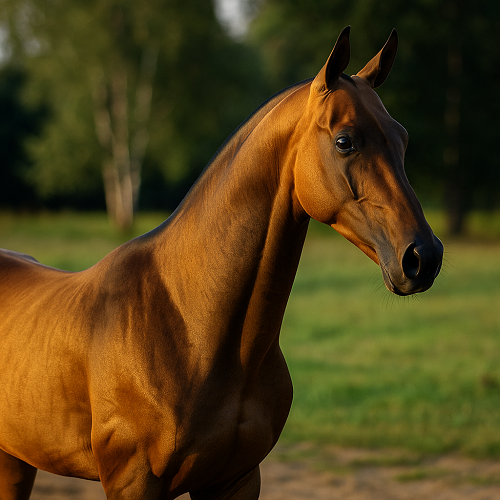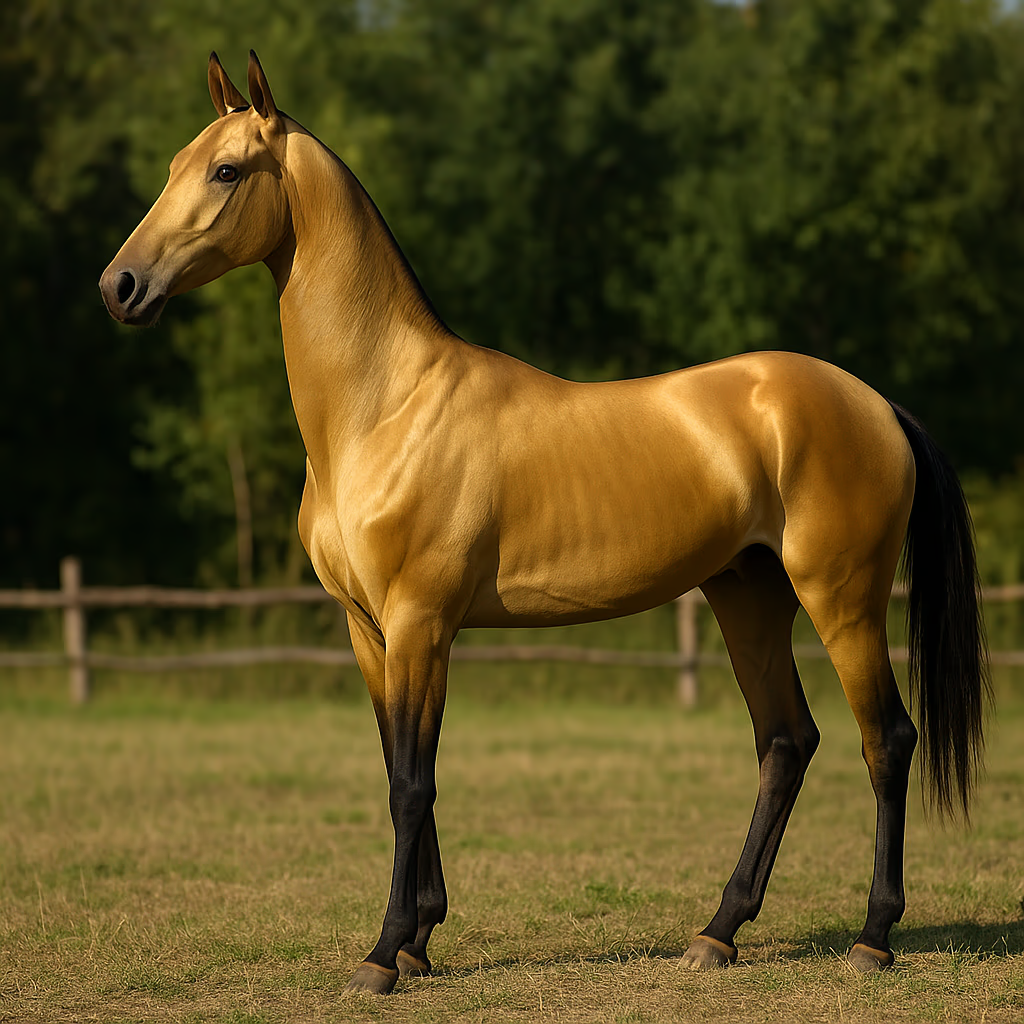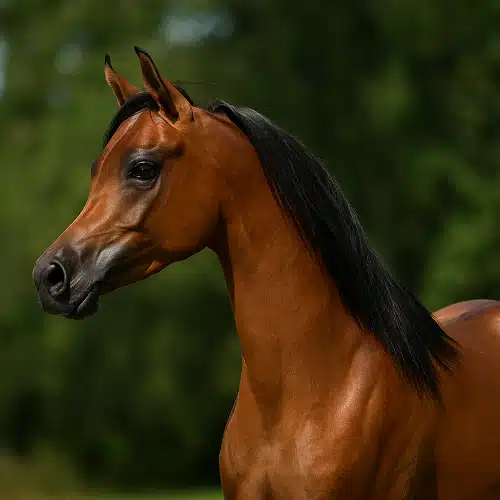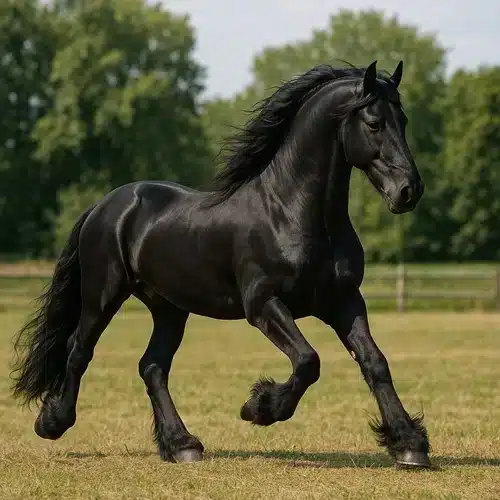The Akhal-Teke horse is one of the oldest and most unique horse breeds in the world. Known as the “golden horse of the desert,” it is distinguished by its incredible coat shine, endurance, and loyalty to the rider. It is not only a horse with an exotic appearance but also an athlete with great potential.
Table of Contents

Origin and History
The Akhal-Teke horse originates from the territory of present-day Turkmenistan, with its cradle in the Ahal oasis, located at the foot of the Kopet-Dag mountains. It was there that nomadic tribes, particularly the warrior Teke people, began selective breeding of these horses, focusing not only on their appearance but above all on utility, endurance, and loyalty to humans.
The history of this breed dates back over 3,000 years, making it one of the oldest and most primitive horse breeds in the world. It is believed that the ancestors of the Akhal-Teke horses were closely related to horses that played a key role in the formation of the ancient armies of the Persians, Parthians, Scythians, and other peoples of Central Asia. They were valued as warhorses—fast, agile, brave, and reliable in harsh conditions. They were also used for long journeys and desert races, which required immense stamina and the ability to survive without water for many hours, or even days.
Thanks to long-term geographical isolation, the harsh climate of Turkmenistan, and thoughtful breeding practices, Akhal-Teke horses developed unique traits that have no equivalent in any other breed. Their exceptional resistance to extreme temperatures—from +50°C heat to below −20°C cold—is a result of living in desert conditions. Their bodies are lean, sinewy, and dry in build, which allows them to regulate their body temperature efficiently and conserve energy.
Their coat is also extraordinary—shiny, metallic, often in golden shades, which earned them the nickname “golden horse.” In sunlight, their coats shimmer like polished metal, evoking admiration from breeders and horse lovers around the world. Thanks to this exceptional beauty and the legend that has grown around the breed, the Akhal-Teke is often called the golden horse of Turkmenistan and serves as the country’s national symbol.
Akhal-Teke horses are also known for their incredible endurance—they can cover hundreds of kilometers a day, as proven in many long-distance endurance rides. One legendary feat occurred in the 1930s, when a group of Turkmen riders on Akhal-Teke horses traveled nearly 4,300 km from Ashgabat to Moscow in just 84 days, including three days without access to water during the crossing of the Karakum Desert.
Another important feature is the strong bond these horses form with humans. Due to the challenging breeding conditions and close contact with their handlers, Akhal-Teke horses are exceptionally loyal, intelligent, and sensitive. They often form relationships based on trust and devotion, which makes them demanding in training—they do not tolerate brutality or inconsistency. However, they are capable of repaying kindness with remarkable cooperation and willingness to work, which is why many experienced riders describe them not just as mounts, but as true partners—the golden horse that gives its heart to only one rider.
Appearance and Distinctive Features
The Akhal-Teke, known as the “golden horse,” has a very characteristic silhouette—slender, elongated, and refined.
Typical breed characteristics:
- Height at the withers: 150–165 cm
- Dry, long head with large eyes
- Long, flexible neck
- Prominent withers, long and supple back
- Sloping croup, thin but strong limbs
- Short, shiny coat with no undercoat
- Sparse, often silky mane and tail
Coat colors: bay, palomino, dun, black, and gray.
Palomino (golden cream) horses are famous for their metallic sheen, which earned the breed its nickname: the “golden horse.”
We encourage you to read the article: Arabian Horse – History, Characteristics, and Why It’s One of the Oldest Breeds – Through life on horseback
Character and Temperament
These horses are extremely loyal to their rider. They are intelligent, alert, and independent. They do not tolerate harsh treatment—they require gentleness and understanding.
Their strong survival instinct makes them cautious but not skittish. They are not ideal for beginners, but with a good bond, they can become wonderful working partners.
Long-Distance Endurance Riding
For centuries, Akhal-Teke horses have been renowned for their remarkable endurance, making them excellent mounts for long-distance rides. Thanks to their efficient metabolism, these horses can function with minimal food and water while preserving energy during many hours of intense effort. Their lean, dry build allows for effective thermoregulation, and they perform well even in high heat.
In endurance races ranging from 80 to 160 kilometers (and even longer), Akhal-Tekes have proven their quality time and again. Their naturally light movement, resistance to fatigue, and willingness to cooperate with the rider make them ideal for challenging routes with varied terrain—from mountain trails to desert paths. In Central Asia and the Caucasus, they are still used in traditional endurance rides that serve both as sport and as a tribute to ancient caravan routes.
Equestrian Sports (Dressage, Show Jumping, Eventing)
Although Akhal-Teke horses are not as massive as Hanoverians or Holsteiners, they can successfully compete in Olympic disciplines. They possess elastic movement, high intelligence, and a strong desire to learn, which makes them well-suited for dressage. Thanks to their conformation—long legs, light build, and energetic movement—they can surprise with the precision of their figures and elegance of their motion.
In show jumping, they achieve good results, especially at lower and intermediate levels. Their agility, reflexes, and determination allow them to navigate courses with strong dynamics. In eventing, they prove to be reliable in the cross-country phase and perform well in both dressage and jumping rounds.
However, they require an experienced rider who understands their independent nature and offers training based on trust. In the hands of a patient trainer, the golden horse can truly shine and become a genuine sporting partner.
Shows, Parades, and Historical Reenactments
The unique beauty of Akhal-Teke horses—their slender build, long swan-like neck, and characteristic shiny coat—makes them visually striking. As a result, they are frequently featured in oriental horse shows, equestrian galas, professional photo shoots, and advertising campaigns.
They are especially popular in historical reenactments and parades, where they play the role of warhorses from ancient civilizations such as the Persians, Scythians, Parthians, or Sarmatians. Their exotic appearance perfectly reflects the spirit of bygone eras, and their proud presence captures the attention of both audiences and directors. It’s no surprise that Akhal-Teke horses have also appeared in feature films and historical productions, often cast as royal or battle steeds.
Gaits and Abilities
The Akhal-Teke moves lightly, with spring and economy. Its movement is smooth and rhythmic, though less showy than that of classical breeds.
- Walk – long, calm, unhurried
- Trot – elastic, with good back engagement
- Canter – extended, flowing, and extremely enduring
Their rhythm and efficiency of movement are especially valued—they can cover great distances without showing signs of fatigue.
Breeding and Bloodlines
In Turkmenistan, the breeding of Akhal-Teke horses is considered a part of the country’s national cultural heritage and is strictly supervised by state breeding institutions. The Akhal-Teke horse has been officially recognized as a national symbol, and its image appears on the emblem and coat of arms of Turkmenistan. Breeding traditions are passed down from generation to generation, and these horses are a source of national pride, accompanying the Turkmen people for thousands of years.
Studbooks (such as the General Studbook maintained by Turkmen Atlary and the International Studbook ITSB) contain precise records of all Akhal-Teke stallions and mares. The selection process for stallions is extremely rigorous—animals must exhibit not only excellent breed type but also proper utility traits and good character. Selection is often carried out by official breeding committees and includes assessment of conformation, movement, and performance in sport or racing.
Major Akhal-Teke Sire Lines
The breed includes a dozen or so male lines (sire lines), several of which dominate the modern population. The most prominent and commonly encountered include:
- Gelishikli (Гелишикли) – Descended from a stallion born in 1953. Horses from this line are known for their good temperament, balance, and strong conformation. They are frequently used in dressage and endurance riding and are also noted for their elegant movement.
- Kaplan (Каплан) – Founded by a stallion born in 1946. Horses from this line are fast, light, and often suited to racing disciplines. They possess a dynamic temperament and high stamina. Less common in Western European breeding, but highly valued in Asia.
- Sovkhoz 2 (Совхоз 2) – Traces back to the stallion Sovkhoz II (born 1941), a son of the famous stallion Skak. Horses from this line are graceful, with elegant, light movement, and are well-suited to dressage. They are often seen in shows and parades where their appearance stands out.
- Peren (Перен) – Named after a stallion born in 1956. This is the largest and most widespread line in modern breeding. Horses are balanced, harmonious, and versatile, making them popular in sport-oriented breeding programs, including in Europe. They perform well in eventing, endurance, and dressage.
Other significant lines also exist, such as Skak, Arab, El, Sere, Karlavach, Toporbai, and Melekush—each contributing slightly different traits to the gene pool. The importance of each line depends on breeding goals (e.g., sport, show, performance, or preservation of the genotype).
Akhal-Teke Horses in Poland
Although Akhal-Teke horses are rare in Central Europe, the breed is gradually gaining popularity in Poland—especially among experienced riders, enthusiasts of oriental breeds, and those interested in long-distance endurance riding and natural training methods.
The first individuals of this breed began appearing in Poland in the 1990s, but real interest only began to grow after the year 2000. Today, there are several private breeders and stud farms in the country that raise Akhal-Teke horses. These are usually small, enthusiast-led centers that have imported horses mainly from Russia, Kazakhstan, Ukraine, and occasionally from Turkmenistan (although direct export from Turkmenistan is very difficult due to state restrictions and breeding policy).
Among the well-known and active breeders in Poland are farms located in the Masovian, Greater Poland, and Lower Silesian voivodeships, where both breeding programs and sport training are carried out. The horses often have documented pedigrees in the International Studbook (ITSB), and some are registered with the Polish Horse Breeders Association (PZHK), although the Akhal-Teke breed does not have a separate studbook in Poland—horses are usually entered into the register of foreign breeds.
Use of Akhal-Teke Horses in Poland
In Poland, Akhal-Teke horses are not yet widely seen in competitive sport, but their numbers are steadily increasing, as is interest from both sporting and recreational communities. The most common uses of the breed in the country include:
- Endurance riding – Thanks to their stamina and efficient metabolism, these horses perform exceptionally well in this discipline. Although the endurance riding scene in Poland is small, it is steadily developing, and Akhal-Tekes are gaining recognition.
- Equestrian shows and events – Their exotic appearance, proud movement, and shiny coats make Akhal-Teke horses frequent participants in breeding shows, parades, and historical reenactments. They draw great public attention, and their originality makes them stand out from other breeds.
- Natural training methods – Due to their intelligence and sensitivity, these horses respond well to natural training techniques based on trust and groundwork. They are often chosen by people practicing horsemanship and positive reinforcement training.
Their balanced character, loyalty, and sensitivity mean that working with an Akhal-Teke requires a conscious and patient rider. In return, the horse can offer a deep bond and strong willingness to cooperate—qualities especially appreciated in communities that value human–horse relationships.
Breeding Challenges in Poland
Breeding Akhal-Teke horses in Poland is not easy. The limited number of individuals, difficulties in accessing new genetic lines, and the need to import stallions or semen from abroad mean that developing the population requires commitment and significant financial investment. Additionally, these horses are not considered a “commercial” breed—they are rare, expensive, and require specialized care, which limits their popularity in mainstream recreational riding.
Despite this, Polish breeders continue their efforts to preserve the breed’s purity and promote its unique traits. Thanks to their dedication, the Akhal-Teke—the golden horse of the East—is beginning to take root on European soil.
Fun Facts and the Legend of the Golden Coat
- Akhal-Tekes were given as diplomatic gifts to tsars and emperors.
- A horse named Absent won a gold medal in dressage at the Rome Olympics in 1960.
- In Turkmen culture, the breed is a symbol of national pride—it even appears on the country’s coat of arms.
- Their coat has a unique light-reflective structure, which creates the famous metallic sheen.
Care and Health
Although Akhal-Teke horses are known for their resilience and exceptional endurance, they require informed care tailored to their specific needs. Bred in the harsh climate of Central Asia, they adapted to tough conditions, but their exotic conformation and sensitivity in certain health aspects demand special attention—especially in European climates.
Cold Protection – No Undercoat
One of the most important characteristics of Akhal-Tekes is the absence of a thick undercoat—a typical feature of desert horses. Their coat is thin, shiny, and lies flat against the skin, giving them their legendary metallic glow. However, the lack of an insulating layer means they do not tolerate cold, rain, or dampness well—particularly during autumn and winter. In Poland’s climate, these horses require blanketing (even in open-air stables) and access to a dry, well-ventilated shelter. Keeping them outside without protection can lead to colds, respiratory infections, or weight loss.
Diet – Sensitive Digestive System
Akhal-Tekes have a very efficient metabolism, meaning they do not require large quantities of feed. However, their digestive systems are sensitive—especially to changes in feed quality, excessive starch, or trace mineral deficiencies. Recommended feeding includes:
- High-quality hay (often sufficient as a base),
- Low-sugar forage products,
- Electrolyte, zinc, and selenium supplements (especially for horses in training),
- Small portions of concentrated feed—preferably specialized mixes for sport or Arabian horses.
Some individuals are prone to rapid weight loss due to stress, cold, or dietary changes—so dietary stability and gradual transitions are crucial.
Training – Moderate and Condition-Based
Akhal-Tekes are naturally energetic and enduring, but they do not respond well to force-based training. Due to their lean, dry build and delicate joints, heavy strength training or work on hard surfaces is not recommended. Ideal exercise types include:
- Conditioning work (e.g., long walks, trail cantering),
- Flexibility and precision-focused training (e.g., dressage, natural horsemanship),
- Moderate jumping or endurance workloads—always after thorough preparation.
Ramping up training intensity too quickly may lead to injury or mental burnout, as these horses are highly sensitive and emotionally responsive.
Hooves – Dry, Hard, but Demanding
Akhal-Teke horses typically have dry, hard, and compact hooves—traits inherited from their desert origins. In natural conditions, their hooves rarely develop problems. However, in Europe—especially on moist ground and soft pastures—they may be prone to:
- Frog rot,
- Softening of the hoof wall,
- Sensitivity to uneven terrain and stones.
It is therefore important to ensure regular trimming (every 5–7 weeks), provide suitable footing (not too wet or muddy), and, if needed, apply protective measures—such as horseshoes or hoof boots. Some horses manage well barefoot, but this depends on stable conditions and how the horse is used.
Longevity and Overall Health
One of the most surprising traits of Akhal-Teke horses is their longevity. The average lifespan of this breed exceeds 25 years, and many individuals live to 30 or more—often remaining active under saddle well into old age. They are also relatively resistant to many common musculoskeletal conditions (such as laminitis or degenerative joint diseases), provided they are properly cared for.
In summary – while Akhal-Tekes are exceptionally hardy and healthy, their exotic nature requires knowledgeable care and living conditions adapted to the breed’s needs. In the hands of an experienced owner, they can amaze not only with their beauty but also with their long-term health and vitality.
Zapytaj ChatGPT
We encourage you to read the article: The Friesian Horse – Characteristics, History, and Uses of This Majestic Breed – Through life on horseback

FAQ
Is the Akhal-Teke Horse Suitable for Beginners?
Not really. This is a horse that requires gentleness, experience, and understanding.
Are Horses of This Breed Resistant to Disease?
Yes, but they require protection from cold and stable feeding conditions.
What Are the Typical Coat Colors?
The most well-known is palomino (golden), but bay, black, gray, and dun also occur.
Can You Buy an Akhal-Teke in Poland?
Yes, although they are rare. There are breeders and importers from Russia, Kazakhstan, and France.
Can This Horse Perform Well in Olympic Sports?
Yes, although it requires a personalized approach and patience. It can be an excellent partner in dressage and endurance riding.


